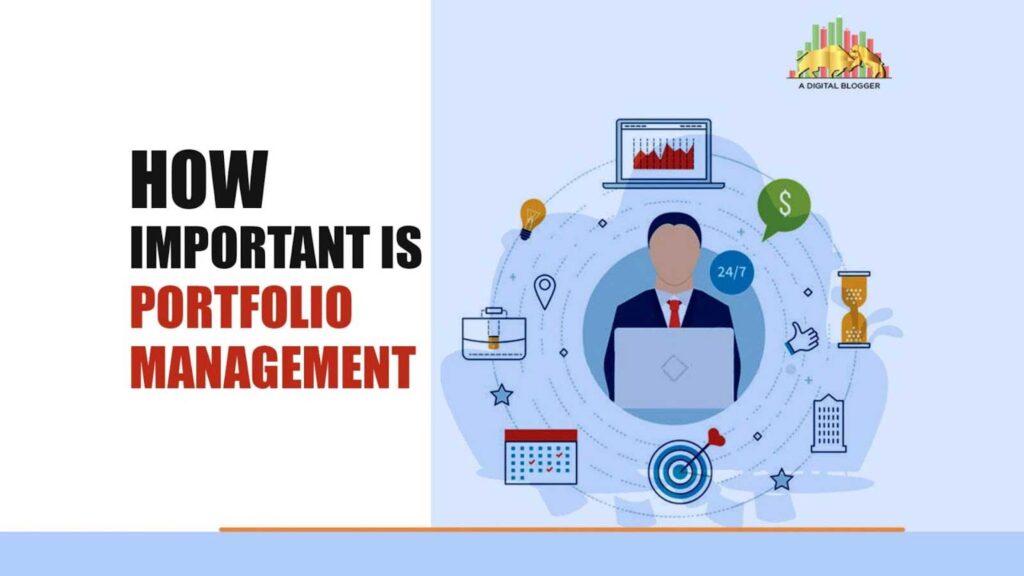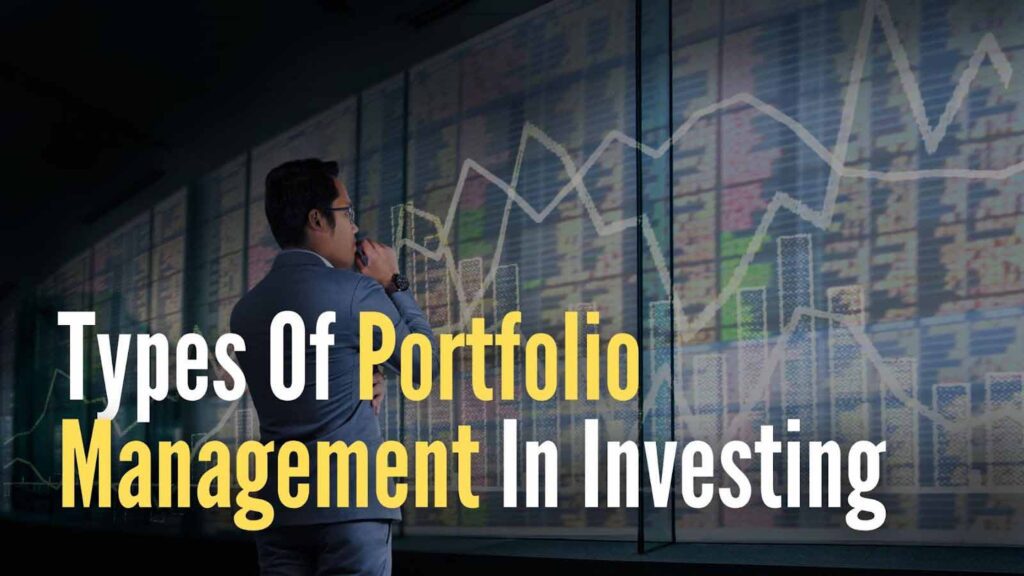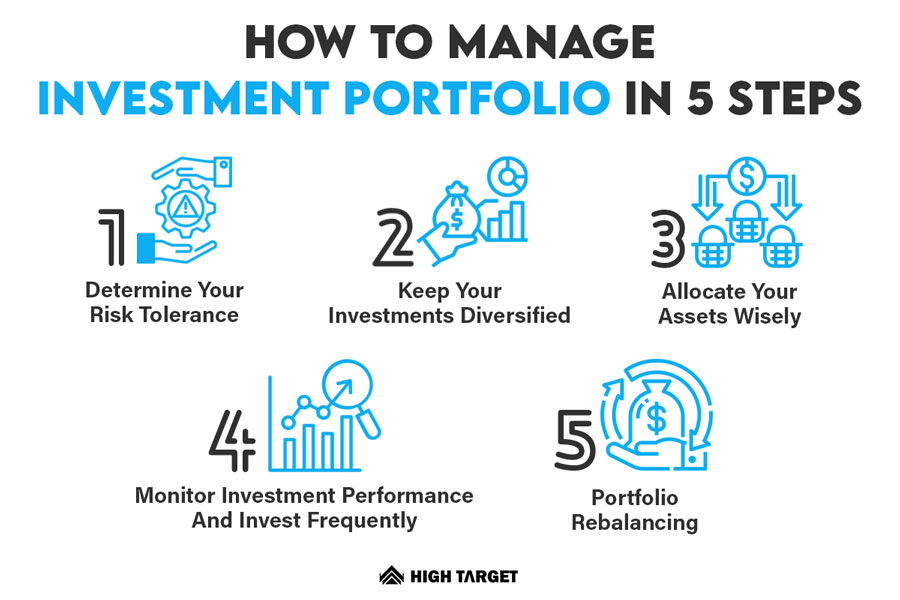
Choosing the correct place to invest your hard-earned money is crucial. If you don’t act wisely while investing your money, you risk losing it, even if you are making a lot of money from your existing business or from a potential MNC company income.
People frequently believe that investing money in the market can be successful and must be simple, but these are the people who ultimately fail to understand this lesson. Your investments’ performance will depend on a number of variables.
If you have a sizable amount of money but keep spending it in quick, impulsive ways, it’s likely that you won’t make any money from it, and it could harm both your financial situation and your emotional state.
So, in order to make some wise investments, you must comprehend some fundamental concepts and take certain actions. We’ll give you advice in this article by going over the five steps to managing Investments and managing investment portfolios. For a thorough grasp of how investments operate, read the complete article.
Before getting into the steps, let’s cover some basic information about the portfolio management process, like what an Investment Portfolio is and how it works. Let’s get started.
What Is An Investment Portfolio?

A portfolio is a collection of financial assets, such as stocks, bonds, commodities, cash, and cash equivalents, such as closed-end funds and exchange-traded funds (ETFs).
Most people think that a portfolio’s core consists of stocks, bonds, and cash. Although this is frequently the case, it need not be the exception. A portfolio could include a variety of assets, such as private investments, real estate, and fine art.
You have the option to hold and manage your portfolio yourself or to outsource portfolio management to a money manager, financial advisor, or other financial experts.
The wisdom of diversification, or more simply, not placing all your eggs in one basket, is one of the fundamental ideas in portfolio management.
Investments are spread over different financial instruments, industries, and other categories in an effort to lower risk. By investing in many sectors that would each respond to the same event differently, it seeks to optimize profits. There are numerous ways to diversify.
It’s up to you which method you use. How you construct your portfolio depends on a variety of criteria, including your personality, your risk tolerance, and your long-term goals.
Regardless of the asset composition in your portfolio, all portfolios should have some level of diversification and reflect your risk tolerance, return targets, time horizon, and other relevant limitations, such as your tax situation, your liquidity needs, your legal obligations, and other special circumstances.
Investment Portfolio Management

The process of choosing the finest investing tools for a client in terms of the lowest risk and highest returns is referred to as portfolio management. It is an art to manage one’s investments in a way that will allow him to maximize returns throughout the course of the intended investment horizon.
The process of managing an individual’s investments under the direction of knowledgeable portfolio managers is described in another definition of portfolio management.
An investment portfolio can be compared to a pie that has been cut into various wedge-shaped pieces, each of which represents a distinct asset class and/or type of investment. To attain a risk-return portfolio allocation that is suitable for their degree of risk tolerance, investors attempt to build a well-diversified portfolio.
Although cash, stocks, and bonds are typically thought of as the three main components of a portfolio, you can expand your holdings with a wide range of assets, including real estate, gold stocks, other kinds of bonds, artwork, and other collectibles.
An investor with a low-risk tolerance would choose the example portfolio allocation shown above. A conservative strategy, in general, seeks to preserve the value of a portfolio by making investments in securities with lower risk.
Blue-chip or large-cap stocks might make up the 20% stock allocation, and high-yield savings accounts, cash, and CDs could make up the 30% of short-term investments.
Why Is Portfolio Management Important?

Investments are not something you make once and then put aside. Portfolio management implies that items are monitored on a regular and consistent basis, not that the portfolio is continuously monitored.
Investor circumstances may change. Their goals and desires may vary as time goes on and as their lives change. Portfolio repositioning may be necessary for light of these events.
It can be necessary to replace specific assets occasionally. An actively managed mutual fund could have its management changed. The portfolio manager may decide to change the fund holding as a result of this.
A portfolio strategy for investing is also essential. Some investors just compile a portfolio of different assets without giving their many different investments any thought. Due to an over-allocation of assets in one industry, the investor may be exposed to greater risk than they had originally anticipated.
Who Should Opt for Investment Portfolio Management?
The following individuals should consider portfolio management –
- Investors that wish to invest in various investment options such as bonds, stocks, funds, commodities, and so on lack the knowledge of the complete process.
- Those with limited expertise in the investment market.
- Investors who are unaware of how market dynamics affect investment returns.
- Investors who do not have enough time to track their investments or rebalance their investment portfolio.
Individuals must implement tactics that meet the investor’s financial strategy and prospects in order to make the most of the managerial process.
Goals Of Investment Portfolio Management

The fundamental purpose or the main objective of portfolio management is to help you invest in a way that will help you optimize returns while reducing risks in order to achieve your financial goals.
1. Stable Return Rate
Once investment safety is established, an investment portfolio should generate a consistent stream of return income. Please take note that your present returns should at least cover the opportunity cost of your funds. Furthermore, by “current return income,” we refer to the return produced by dividends rather than capital gains.
2. Higher Marketability
Investment instruments that are simple to market make up a well-managed portfolio. Consider it in this way: You will have difficulty promoting your stocks or funds if you have a number of inactive or underperforming assets in your portfolio. Therefore, it is crucial to invest in reputable businesses that are listed on stock exchanges and actively traded by other investors.
3. Tax Planning
For someone with a steady stream of income, taxes are one of the most crucial concerns. Consequently, an owner of a properly managing investment portfolios should benefit from a supporting tax shelter. Not only should income tax be considered, but also other taxes like capital gains tax, gift tax, etc.
Don’t forget that a solid portfolio emphasizes tax planning rather than tax avoidance.
4. Capital Appreciation
A strong investment portfolio generates capital growth to shield the owner from inflationary or deflationary pressures that might otherwise reduce their purchasing power. To put it plainly, an excellent portfolio should contain investments that are likely to increase in real value after accounting for inflation.
5. Optimum Liquidity
A well-balanced portfolio guarantees that the owner will have access to sufficient funds to meet his liquidity demands immediately. It is advised to retain some credit available for use in an emergency.
6. Investment Safety
Last but not least, providing investment safety to the investor is another important goal of portfolio management. Only until your investment safety is guaranteed do other factors, such as returns, gains, and growth, start to matter.
Types Of Portfolio Management In Investing

1. Active Portfolio Management
An active portfolio manager seeks to outperform the market in terms of returns. Those who invest in this manner are frequently unconventional in their thinking. When stocks are inexpensive, active managers buy them; when they climb over the benchmark, they sell them.
Active portfolio management includes the quantitative analysis of firms to evaluate the cost of stock in relation to its potential. The active manager accomplishes this by rejecting the efficient market hypothesis and instead relies on ratios to back up his claim.
To decrease risk, the active manager strives to diversify his investments across other sectors. The issue with active portfolio management is that success is totally dependent on the manager’s ability. However, if you can find one with the necessary skills, the value investing strategy is likely to produce positive outcomes.
2. Passive Portfolio Management
The passive investment strategy is the polar opposite of active management. Those who believe in the efficient market hypothesis have this belief. The idea is that the fundamentals of a firm will always be reflected in its stock price. As a result, the passive manager prefers low-turnover index funds with high long-term value.
Your money is invested in index funds in accordance with market capitalization. This means that for every 100 put in the 500 funds, 2 will be invested in the firm that represents 2% of the index.
The purpose of selecting a lower yield is to save money on management expenditures while still reaping the benefits of stability.
3. Discretionary Portfolio Management
A discretionary manager is given complete freedom to make decisions on behalf of the investment. While individual goals and timetables are considered, the manager selects the plan he believes is best.
After giving over the funds to the expert, the investor sits back and awaits the earnings.
4. Non-Discretionary Portfolio Management
A non-discretionary [ND] manager is nothing more than a financial advisor. He counsels the investor on the best course of action. While the pros and cons are clearly presented, the investor is free to choose his own path. Only until the manager has been granted authorization to act on behalf of the investor does he make a move.
Whether you employ a portfolio manager or do the work yourself, it’s vital to select a viable method and ensure that it’s presented logically. Maintaining a decent portfolio provides the advantage of eliminating confusion while providing assets that are matched to the individual’s objectives.
Ok, now you have sound knowledge about what investing portfolio management is and its types and goals. It’s time to learn how to manage an investment portfolio in 5 steps. Let’s get started.
How To Manage Investment Portfolio In 5 Steps

1. Determine Your Risk Tolerance
In investment words, the risk is the degree of uncertainty or potential financial loss that you accept while making any financial decision. Even holding your savings in cash poses a risk because inflation will gradually diminish your purchasing power.
Typically, risk and return are inversely connected. The greater the risk, the greater the possible profit. Individual stock shares are generally riskier than government securities; cash carries little to no risk other than the potential loss of buying value over time. Equity shares have higher potential rates of return to reflect their higher level of risk than government securities, which have lower yields but considerably more stable values.
Before you can decide which assets are best for your portfolio, you must first identify your risk tolerance. This will define how much of each form of assets, such as equity stocks or government securities, you will invest in.
There are four major elements that can influence your risk tolerance:
Risk-taking ability – This is essentially your risk tolerance, which is impacted by your present income, existing loans, and other commitments, and, to some extent, your age. In general, a young person with a high income and minimal liabilities should be able to take more risks.
Risk must be taken – The need to take risks is mostly determined by your financial goals and the rate of return required to attain those goals. Thus, if you want to make a down payment on a home in 5 years, you may require larger returns on your investment and thus be willing to take on more risk.
Willingness to take risks – This is a behavioral element that is not as simply quantified as the previous two. Willingness to take risks generally refers to your comfort level with risk.
Time horizon – The investment time horizon is a significant factor in evaluating your risk tolerance. In general, the ability to take risks decreases as the investing time horizon decreases. Assume Meg has a 6-month investment horizon and Shawn has a 3-year investment horizon. If all else remains constant, Shawn will be able to take greater risks than Meg.
Your risk profile might be classified as aggressive, moderate, or conservative based on an examination of the four characteristics listed above.
- If you have a high-risk tolerance, you should allocate around 80% of your portfolio to stocks and 20% to bonds.
- If you have a moderate risk tolerance, you should allocate roughly half of your portfolio to stocks and the other half to bonds.
- If you have a low-risk tolerance, you should allocate roughly 20% of your portfolio to equities and 80% to bonds.
After determining your risk tolerance, you may create your portfolio with investments that complement your risk profile.
2. Keep Your Investments Diversified
Your next goal should be to create a diverse portfolio that provides optimal returns while also protecting your capital from unfavorable events.
As the previous year has shown, we can never be confident of what the future contains. As a result, it is critical that your investment portfolio is designed to withstand the uncertainties and curve balls thrown your way. By investing in a diverse range of investment kinds and firms, you can achieve diversification and reduce risk.
In this manner, if one firm or sector of companies gets struck particularly hard by the market, other investments will ideally assist prop it up and reduce the overall money you lose in the short term. This ensures that no single investment in your portfolio has a significant impact on the entire portfolio risk and return.
3. Allocate Your Assets Wisely
Asset allocation refers to the percentage of each form of investment in your portfolio and is essential for attaining optimal diversification. Factors influencing asset allocation include:
- Your expected returns
- Your risk tolerance
- The duration of your investment.
For example, if you have an aggressive risk profile, want to create large returns, and have an investing time period of more than ten years, your portfolio asset allocation can look like this:
- 80% allocated to stocks
- Bonds receive 15%
- 5% allocated to cash or cash equivalents
However, this is a highly simplified perspective of asset allocation. Ideally, you would analyze the entire investing spectrum and diversify your portfolio among two or three investment possibilities, such as a stock fund, a bond fund, and maybe an international stock fund.
4. Monitor Investment Performance And Invest Frequently
After assessing your risk profile, diversifying your portfolio, and deciding on the optimal asset allocation option for you, you must monitor the performance of your investment.
Assessing the performance of your portfolio on a regular basis ensures that you are on track to meet your financial objectives. If your portfolio’s performance falls short of expectations, you must investigate and determine why.
Pose queries such as:
- Is it due to causes beyond your control, such as a broader economic slowdown?
- Is the poor performance only temporary?
- Is the poor performance the result of short-term or long-term factors?
Tracking your investment performance allows you to course correct in a timely manner. However, you must not be hasty in responding to underperformance. For example, because equity markets are volatile, equity investments may experience periods of underperformance, which may impair your portfolio results.
However, selling your stock assets and switching to bonds may not be the greatest move if the underperformance is temporary, as you may miss out on their comeback and lock in the accrued losses.
Furthermore, frequent and disciplined investing helps keep you on track to meet your financial objectives. You can benefit from dollar-cost averaging by investing on a regular basis. Simply put, when you invest regularly, you buy at all levels of the market, which helps to minimize the average cost of purchase.
Investing on a regular basis also relieves the strain of trying to time the markets and buying at market lows.
5. Portfolio Rebalancing
A periodic assessment also allows you to determine whether you are adhering to your asset allocation strategy. Without regular tune-ups, your portfolio may become excessively aggressive or conservative for your risk profile, lowering your chances of meeting your objectives.
If stock shares have a strong year, for example, the value of your portfolio will most likely increase to reflect the higher value of equities. If the stock market underperforms, your portfolio will lose a larger percentage of its value than you may have desired.
Similarly, if equities are underperforming, the value of your portfolio may shift toward safer assets such as government bonds. While it may appear illogical, you may want to sell some bonds in order to purchase additional equity shares in order to maintain your long-term profits. Too cautious a portfolio may prohibit you from attaining your financial goals—you will not receive the same level of returns when the market rebounds if your portfolio is too conservative.
You may be wondering when you should rebalance. The following circumstances may prompt you to consider rebalancing your portfolio:
- Suppose your asset allocation has shifted due to sharp changes in any one asset class. A rebalancing is usually triggered by a deviation of greater than 20%-25%.
- Suppose you have strayed from your asset allocation strategy for more than six months if you have attained a target and need to exit an investment or change to a safer investment.
- If your risk tolerance or personal circumstances change.
Conclusion
That’s all there is to know about investment portfolio management. We understand that managing your portfolio takes time and effort, but there are some basic steps you can take to make the process easier and faster. We’ve gone over all of the major portfolio management basics, and now it’s up to you to understand and apply them.












